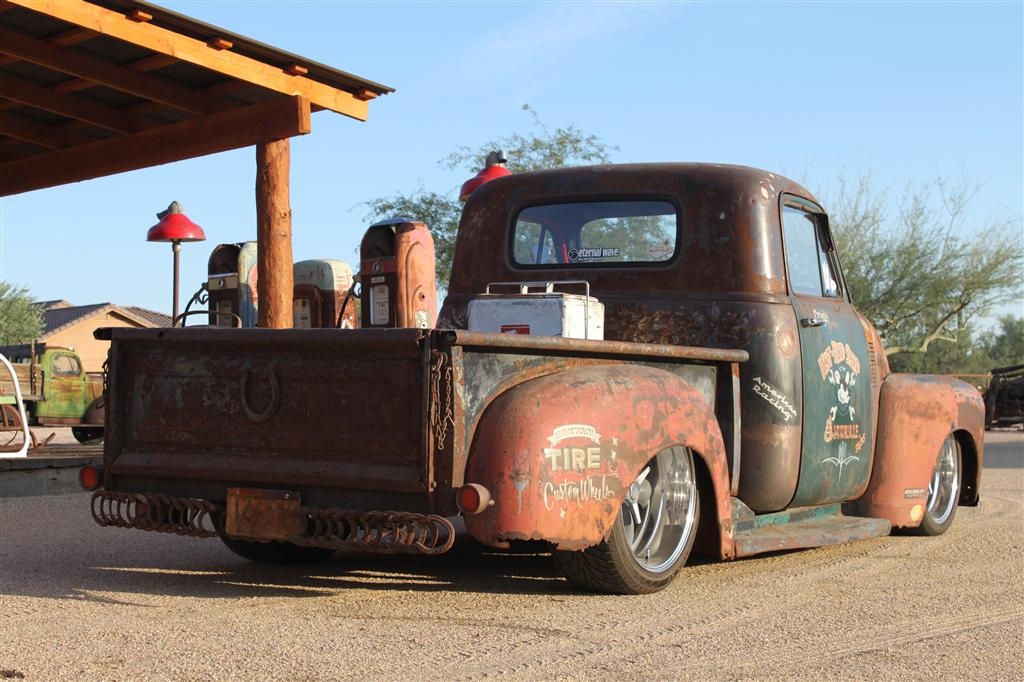SCM Analysis
Detailing
| Vehicle: | 1954 Chevrolet Pickup (Custom) |
| Years Produced: | 1947–55 |
| Number Produced: | 1,000,000 |
| Original List Price: | $1,419 |
| SCM Valuation: | $10,000–$30,000 |
| Tune Up Cost: | $150 |
| Distributor Caps: | $12 |
| Chassis Number Location: | On plate on left front inner door post |
| Engine Number Location: | On pad in front of right cylinder head (small-block Chevrolet V8) |
| Club Info: | American Truck Historical Society, P.O. Box 901611, Kansas City, MO 64190-1611 |
| Website: | http://www.aths.org |
| Alternatives: | 1948–52 Ford F-1, 1948-53 Dodge B-series, 1949–51 International R-series |
| Investment Grade: | C |
This truck sold for $28,600 at Barrett-Jackson’s Scottsdale sale on Jan. 17, 2012. There may be more difficult things to explain than how a 60-year-old, clapped-out, rustbucket of a pickup truck can, recession or not, cross an auction block just a whisker shy of $30,000, but not very many come to mind. So what’s going on here?
From a purely mechanical standpoint, the truck possesses all the usual bits and pieces you would expect to see on any well-built custom that’s meant to be used in the modern world. The chassis has been updated with adjustable air-ride suspension for a perfect stance, big wheels and brakes provide much improved tractability and a custom look, and a simplebut- functional small-block Chevy built with all the familiar names should be trouble-free and powerful enough. Creature comforts include air conditioning, updated electrical components and a nicely upholstered interior. All good points, but none of them are the real story behind this sale.
The truck itself holds no relevant historical value other than the fact that it’s old. It’s not uncommonly rare, and it’s one of thousands of GM Advance Design trucks still on the road. It is not a one-of-one anything. So where is the value? Where is the profitability? What’s the point? It all comes down to one thing: patina.
What is patina?
Literally defined, patina refers to the film that grows on metallic surfaces due to oxidation over long periods of time. The definition is simple to understand, but answering the question of why anyone would pay for it is not. To further complicate the question, why has patina grown to be so desirable that it is being intentionally preserved and even faked?
The answer may lie in another definition of the term. Figuratively translated, patina can come to represent an impression or appearance of something.
Shop logos, rust are the new cool
Why then are the majority of celebrated, preserved, and affectionately re-created patina finishes found on old pickups? A strong clue may be found dead center of that crusty profile, spelled out for us in hand-laid lettering: Hot Rod Shop.
Hiding somewhere in the background of every historic quarter-mile pass, every land-speed record and every America’s Most Beautiful Roadster lived a vehicle, usually a truck, which served as the “go-fer,” the pusher, the tower and daily transportation to and from the workspace. Shop trucks often served as rolling billboards that were ridden hard and put away wet, but were vital nonetheless. Many racers, customizers and restorers have crashed, chopped and rebuilt more cars than they can remember, but I’m willing to bet that most remember the trucks that let them get to work.
It is this history, one of an all-encompassing car lifestyle, that trucks like this impress upon us. Dents come with stories, and rust has been earned. And it doesn’t really matter if this particular truck actually was a vintage shop parts hauler or not — it has the look, and now it is likely to be most enjoyed from the driver’s seat. No need to worry about rock chips with this one. It’s a way to haul greasy parts in style.
The patina trend is further strengthened by simple economics. Not only do the prices of classic cars and trucks continue to climb, but so does the cost of the techniques and materials used to restore and refinish them. As a result, the financial value of many refinished classics is simply too great to risk driving regularly, if at all, and many would-be owners are priced out of the game altogether. But what’s interesting is the increase in value that patina is seeing, with trucks like this one achieving prices close to what a restored original might bring, without the added cost of complete restoration. The rising tide of restored trucks is lifting them all.
Buying the truck, or the lifestyle?
To some, this is just rusty junk. But those who embrace the patina movement may argue that their intentions are simply to realign where they choose to pursue value in their cars. Patina and its impression of history (real or implied) can add value and interest to vehicles that would otherwise have none. Repurposing these machines may help remind us that it is often the car lifestyle we find most valuable. For those of us intoxicated by the aroma of liquefied rubber, liberated by the release of a clutch pedal, and appreciative of the space between here and there, the beauty is in the purpose.
So is the new owner of this ’54 crazed or just plain crazy? He just bought a comfortable, reliable, dailydriver of a custom truck with the attitude of a rusty nail and a paintjob that never needs to be washed. I think it was well bought, and a perfect example of accomplishing more by doing less
